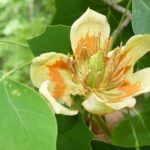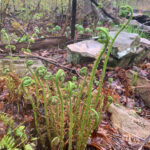One of the greatest challenges we, as a culture, face is transitioning to sustainable practices and making those practices mainstream rather than fringe activities. In some parts of the country, even access to local foods is not possible; in others, like my own, we have a number of knowledgeable experts that deal in sustainability and interest in sustainability, however, our sustainable activities are not mainstream. The one mainstream activity that I can think of is going to a farmer’s market, which nearly everyone knows about and lots of people enjoy doing. But what about other sustainable activities, like converting your lawn into edibles, edible forest gardening, driving a biodiesel car, not purchasing new items, or eating a 100 mile diet? These seem to be more “fringe” activities that only a select few who are in the “know” are able to do. And I won’t even mention the huge number of people who do not see sustainability as necessary at all. So in this post, I want to tell the story of my own campus, and the critical importance of making “invisible” activities visible. I tell this story because I think the story of my campus is not just a story of my campus, its a story of what is happening all throughout the United States, in that sustainable activities are in the fringe and we need to move these activities to the center.

Let me start by telling you a bit about my campus. My campus is not a small one–its a suburban public university with 20,000 students. In terms of unsustainable practices, we’ll start with the recycling program, which is just shameful. Most of the time, if you want to recycle, you can’t. Recycle bins are so few and far between that you have to seek them out, sometimes even in a different building. One recycle bin is shared between three floors of a building, so you never know where its going to be–and it only takes paper products when you can find it. Its impossible to recycle anything that isn’t paper–the only bottle/can recycle bin I have found on campus is always overflowing. Since people are in a hurry and the system has not empowered them to recycle, they don’t recycle and so much is wasted. Other features of my campus that are important to note: there is a “main” part of campus and then a ton of other land with other things that aren’t part of the academic campus (like, say, unsustainable golf courses). My campus also doesn’t have a good bus system that goes to non-academic parts of campus (well, ok, it doesn’t have a good bus system, period).
One of the things I am doing this fall is teaching an undergraduate course in interdisciplinary research methods with a theme of globalization and sustainability. As part of this course, I’m taking my students on field trips to various places on campus that are engaging in sustainable practices–and let me tell you, they were not easy to find! On the 1st day of my class, we did a “sustainability” walk through campus and looked at the massive lawns free of dandelions and being over-watered, the lack of recycle bins, the overflowing trash bins, the overfull parking lots (because our campus is in “overshoot” mode with the growing number of students, to use a term from the Limits to Growth) and our new building on campus that hopefully will get a LEED platinum green rating. The new building is an interesting case; the building’s “greenness” is circulated like juicy gossip among the faculty and student body where nobody can tell you anything specific, just that its “green.” But beyond the nebulously green building, it looks like our campus is doing literally nothing sustainable. But looks can be deceiving.
When you go to the fringes of the campus, suddenly, a wealth of sustainable practices emerge. Three or so miles from main campus is the student organic farm. Its not accessible by anything but car from campus (someone who tried to walk would have to walk through the golf course and would encounter a 8′ fence with barbed wire). The Student Organic Farm is a great place, it has knowledgeable students and faculty engaging in sustainable agricultural practices, re-purposing old buildings, and educating and empowering the campus community (…at least those who are able to find it). So here, tucked into an invisible corner of the campus is a wealth of sustainable activity happening–and nobody can see it. Nobody even knows where on campus it is located. We learned from the director of the farm that she tried to have it established somewhere near main campus….but administrators wouldn’t hear of it because they felt it was going to be an “eyesore.” They put her in the worst spot possible–on what had been a sandy playground, with no actual dirt to speak of, and a bunch of trees south of the garden. Their reasoning was that the trees would block the garden a bit….so it wasn’t able to be seen. Unfortunately, they also block the light, but since the farm has expanded, that original plot became the shady flower and greens garden. They also had to haul in a ton of When I took my students to visit the farm, the farm was in the process of

shutting down for the year. My students and I learned about the farm and then, later, dug some potatoes. In my students’ responses to their visit, several noted how they had never harvested a vegetable before and hadn’t realized that potatoes came “from the ground.” How disconnected we have become from our food supply!
I think its important to note one more thing about sustainability as a fringe vs. mainstream practice as it relates to the farm. At one time, the organic farm’s goal was to grow food for campus dining services so that students could have locally sourced food and organic food. But they found that campus dining services, apparently, doesn’t want real food grown locally. They are a large corporation whose services the university pays for, and they use large corporate practices. They want cheap food, food that has various industrial certifications, and won’t pay a fair price for the farm’s food. So the student farmers, instead, started a campus farm stand to provide more access to real food. So in three ways: accessibility of location, visibility of farm, and impact on students’ eating practices, we see that this wonderful bastion of sustainability is still a fringe activity.
I’m going to give one more example to demonstrate the fringe vs. mainstream concept and how it is happening on my campus. The second place that we visited was a new Clean Energy Research Center. I only discovered the center because my husband served on a committee with someone who knew about it, and I was asking him if he knew of other places my students and I could visit on campus. Like the farm, the clean energy research center must be accessed via car (it also is about 1.5 miles away, with no sidewalks and very dangerous turn in the road). But again, once we arrived, we were able to see a wealth of amazing activities–biodiesel production, geothermal heating, biomass heating and experimentation on biomass pellet production, solar grid systems, solar PV systems, various projects converting normal cars into something more sustainable, etc. The whole building was retrofitted with a highly efficient automated wood chip boiler (which heats using wood chips from dead ash trees all over campus). There, we also learned about other clean energy projects, including a clear

articulation of the green features of the new building, tests for wind power, and plans for biomass central heating plants on campus.
After our first walk, my students and I concluded that our campus was a very 20th century unsustainable campus with a new and already floundering public transportation system and seriously embarrassing recycling program. But by examining activities on the fringes, rather than at the center, we found out that this is not the case. Some really cutting edge things are happening on campus with organic gardening and clean energy. And almost nobody knows about it.
I’d like to return from the microcosm of my campus to the macrocosm of present-day America. The idea of sustainability being on the fringes, being something that hippies and other social outcasts participate in, I think is really still dominant. Its not that we don’t have sustainable activities and things happening. Lots of stuff, important stuff, is happening. The problem is that its happening on the fringes. Its happening in places that people can’t see it happen, and because of that, it remains elusive and inaccessible to the bulk of the American populace. To give an example of this: I’ve talked quite a bit about the problems inherent in the typical green front lawn in terms of unsustainable practices. Part of the problem in overcoming the lawn issue is that people don’t realize there are alternatives or that their current lawn is a problem. They go to big box stores to buy their products for their lawn and that reinforces their behaviors; they haven’t ever been exposed to different ways of tending their property. That’s because people like me who get rid of our lawns are still in the fringes; its not a mainstream practice.
So I think as a community concerned with sustainability, we must start thinking about not only engaging in our practices, but bringing those practices to the masses. Its not enough to do stuff for yourself and improve our own lives; we have to reach out. To educate and empower people and move sustainability into the mainstream.



Sustainability and permaculture is something I would like to study more of.